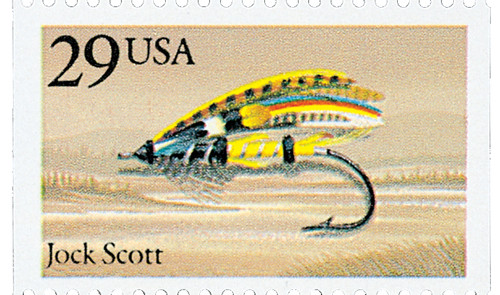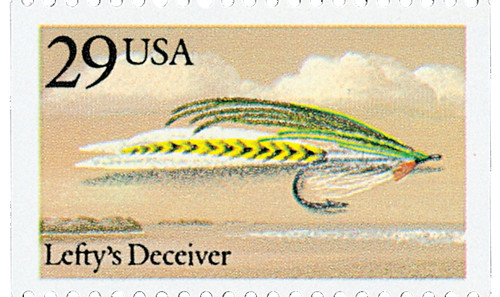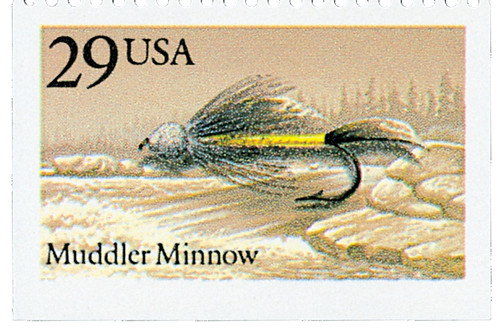
# 2545-49 - 1991 29c Fishing Flies
US #2545-49
1991 Fishing Flies
- Set of five
Category of Stamp: Commemorative
Value: 29¢, First Class Mail rate
First Day of Issue: May 31, 1991
First Day City: Cuddebackville, New York
Quantity Issued: 150,711,600
Printed by: American Bank Note Company
Printing Method: Photogravure
Format: Booklet: 4 panes of 5, from printing cylinders of 275 subjects (11 across, 25 down)
Perforations: 11
Reason the stamp was issued: These stamps appeal to those interested in fly fishing. This was one of the fastest growing sports at the time.
About the stamp design: The Fishing Flies stamps picture five different flies. These are a small portion of the 1,200 patterns of flies. Chuck Ripper, a wildlife artist created the images for the stamps. He had previously designed the 1986 Fish booklet stamps and thought of the idea of showing the flies used to catch the fish. Each fishing fly depicted on these stamps has a background showing a scene typical of where it would be used. Ripper used actual flies as his models for the artwork. The Fishing Flies shown are: Royal Wulff, Jock Scott, Apte Tarpon Fly, Lefty’s Deceiver, and Muddler Minnow
Special design details: The stamps were produced as a five-variety topical booklet. The USPS began producing these in 1985.
First Day City: The First Day of Issue ceremony was held at the Never Sink Valley Area Museum in Cuddebackville, New York. This area is known for its trout fishing.
History the stamp represents: The following flies are pictured on these stamps:
Royal Wulff – Invented by Lee Wulff (1905-1991), an avid fly fisherman who adapted the Royal Coachman fly. The Royal Wulff originally used animal hair for the wings. This fly is popular with trout fishermen.
Muddler Minnow – The Muddler Minnow was developed by Don Gapen of Minnesota in 1936. It was made to look like the small slimy sculpin fish and to attract brook trout. Since its invention, it has become one of the most popular among fly fishermen.
Lefty’s Deceiver – This fly was created by Lefty Kreh, while fishing for striped bass in the Chesapeake Bay. It was designed to look like smelt, a common food of the bass. The fly has become popular among saltwater fly fishermen, and is made in varying colors based on the forage fish a larger fish may eat.
Jock Scott – The Jock Scott fly was developed in England in 1817. It is often used for catching salmon. The original Jock Scott flies used feathers from rare birds such as toucans and Jungle cocks from Asia, as well as peacocks, mallards, and pheasants.
Apte Tarpon – This fly was first made by Stu Apte to catch tarpon, a saltwater fish that can reach lengths of eight feet and weigh over 250 pounds. After a career as a pilot, Apte became a fishing guide in the Florida Keys and has held numerous fishing records.
US #2545-49
1991 Fishing Flies
- Set of five
Category of Stamp: Commemorative
Value: 29¢, First Class Mail rate
First Day of Issue: May 31, 1991
First Day City: Cuddebackville, New York
Quantity Issued: 150,711,600
Printed by: American Bank Note Company
Printing Method: Photogravure
Format: Booklet: 4 panes of 5, from printing cylinders of 275 subjects (11 across, 25 down)
Perforations: 11
Reason the stamp was issued: These stamps appeal to those interested in fly fishing. This was one of the fastest growing sports at the time.
About the stamp design: The Fishing Flies stamps picture five different flies. These are a small portion of the 1,200 patterns of flies. Chuck Ripper, a wildlife artist created the images for the stamps. He had previously designed the 1986 Fish booklet stamps and thought of the idea of showing the flies used to catch the fish. Each fishing fly depicted on these stamps has a background showing a scene typical of where it would be used. Ripper used actual flies as his models for the artwork. The Fishing Flies shown are: Royal Wulff, Jock Scott, Apte Tarpon Fly, Lefty’s Deceiver, and Muddler Minnow
Special design details: The stamps were produced as a five-variety topical booklet. The USPS began producing these in 1985.
First Day City: The First Day of Issue ceremony was held at the Never Sink Valley Area Museum in Cuddebackville, New York. This area is known for its trout fishing.
History the stamp represents: The following flies are pictured on these stamps:
Royal Wulff – Invented by Lee Wulff (1905-1991), an avid fly fisherman who adapted the Royal Coachman fly. The Royal Wulff originally used animal hair for the wings. This fly is popular with trout fishermen.
Muddler Minnow – The Muddler Minnow was developed by Don Gapen of Minnesota in 1936. It was made to look like the small slimy sculpin fish and to attract brook trout. Since its invention, it has become one of the most popular among fly fishermen.
Lefty’s Deceiver – This fly was created by Lefty Kreh, while fishing for striped bass in the Chesapeake Bay. It was designed to look like smelt, a common food of the bass. The fly has become popular among saltwater fly fishermen, and is made in varying colors based on the forage fish a larger fish may eat.
Jock Scott – The Jock Scott fly was developed in England in 1817. It is often used for catching salmon. The original Jock Scott flies used feathers from rare birds such as toucans and Jungle cocks from Asia, as well as peacocks, mallards, and pheasants.
Apte Tarpon – This fly was first made by Stu Apte to catch tarpon, a saltwater fish that can reach lengths of eight feet and weigh over 250 pounds. After a career as a pilot, Apte became a fishing guide in the Florida Keys and has held numerous fishing records.













